How To Repair Cracks In Cement Basement Floor
How to fix and repair
Basement floor cracks
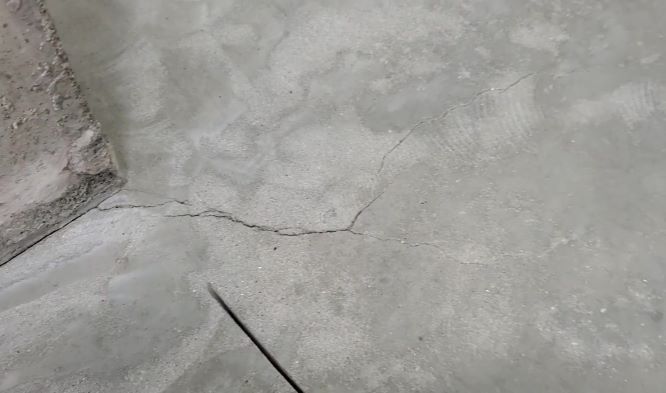 Non structural basement floor fissure
Non structural basement floor fissure
A crack in your basement floor may accept you wondering if there's annihilation wrong with your concrete flooring.
I can tell yous, most basement floors don't support the house, the foundation walls do. So the crack usually isn't a structural outcome.
No question, having a croaky floor is unsightly and understandably cause for concern.
But what I've institute In almost every case (or crack), there's usually a good reason y'all floor cracked and it certainly tin can be repaired.
The well-nigh common types of basement floor cracks
There'due south a few things I wait for when I diagnose a crack in a concrete floor. The width and length of the crack can tell me what type of crack it is and why the floor cracked.
- Hairline Crack - Nearly the width of a dime or less. The length of these cracks tin exist small or long. This fissure is non-structural and quite common. Can be repaired if desired or left solitary.
- Shrinkage Crack - Well-nigh the width of a dime to 1/viii". A freshly poured concrete flooring shrinks as information technology cures. This causes stress on the concrete causing it to crevice. Relief cuts are usually sawed in the floor to command these cracks. Considered non-structural and tin easily be repaired.
- Settlement Crack - Virtually i/8" to 1/two" wide. Ordinarily acquired by the sub-base of operations (gravel) under floor settling. When the gravel was being installed it wasn't properly compacted. Over time the gravel settles (could but exist one/4"). This causes stress on the concrete and a crack forms. One side of the cleft is ordinarily higher or lower than the other side. Could be a structural issue if in that location's a loly column nearby. Floor can exist leveled and repaired or cleaved out and re-washed.
- Heaved Scissure - Well-nigh i/iv" to three/4" wide. Usually acquired by water issue nether the floor or something under the floor pushing upwards (large rock or stump). If the soil under the floor freezes it tin can crusade the floor to boost and fissure. Can be structural result if a begetting wall or loly column is sitting on the floor. Best to suspension out the concrete and set the underlying issue, and so re-pour the physical floor.
- Perimeter Cracks - Where the basement floor meets the foundation walls. Well-nigh one/eight" to ane/iv" wide. This is caused by the concrete flooring shrinking away from the walls. Non a structural upshot but sometimes wet may seep up through here. Can be sealed with caulking.
- Spalling, pop-outs, and flaking - the top 1/viii - one/4 inch of the surface is peeling or delaminating in areas. This isn't really considered a cleft but is harm and tin exist repaired. Usually not structural.
why did my basement floor fissure?
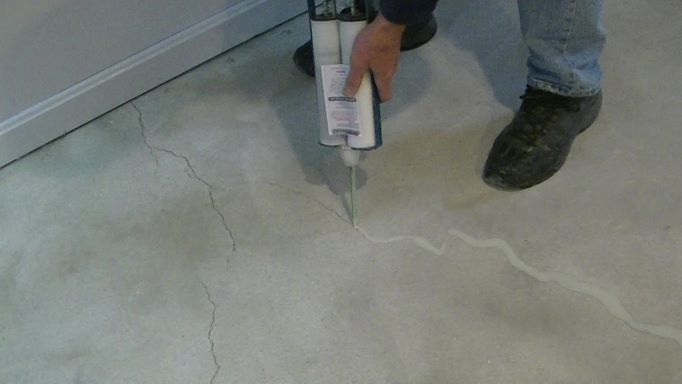 Common basement flooring shrinkage cracks
Common basement flooring shrinkage cracks
There'south a few reasons that could explicate why your basement floor croaky.
- No sawed contraction joints were installed later the concrete floor was poured. A new concrete flooring shrinks during the curing process. If no expansion / wrinkle relief cuts were fabricated later on troweling, in that location'due south a good chance the cracks are "shrinkage cracks".
- The sub-base of operations settled. If the gravel under the concrete floor wasn't properly installed and compacted, it may have settled. If a section of the concrete also settled information technology volition cause the concrete to crevice. This type of cleft commonly has one side of the scissure a footling higher than the other side.
- The physical was poured too wet. Calculation too much mix water when pouring the physical flooring will weaken the concrete and cause it to crevice. These cracks are also called shrinkage cracks.
- No drainage or improperly installed drainage pipes. If there's moisture under your concrete floor that has no way to drain, it volition put pressure "upward" on your concrete flooring and fissure it.
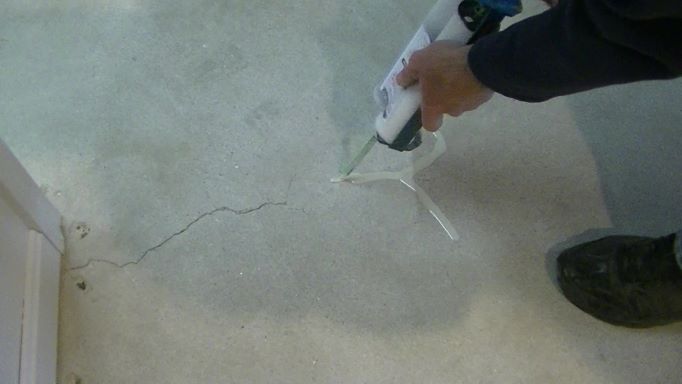
In that location are some other reasons like, too much calcium chloride was added to the mix and it dried too fast, or the concrete was improperly cured. All these volition lead to shrinkage cracking at some point.
If y'all decide the cracks in your basement flooring are due to settling or heaving, then that is a sub-base of operations outcome and the concrete may have to be removed to correct that issue.
Repairing these cellar floor cracks volition only exist temporary if the concrete continues to settle or heave.
If you lot're certain the physical floor is done moving, you can repair those cracks and the shrinkage cracks with an epoxy material y'all inject into the crack and add a silica sand for a filler.
This will weld the crack together creating an splendid basement flooring repair.
what if wet is coming upwards through the cleft
You can see moisture in a couple means.
Get-go , if in that location's a white powdry substance on the floor along the fissure, that's moisture. Moisture vapor is coming up through the crack, carrying lime and minerals from the physical.
The moisture evaporates on the surface of the floor and leaves the lime and minerals backside (white powder called efflorescence).
About likely no moisture vapor barrier was installed under the concrete floor when information technology was installed.
SOLUTION: You tin can spray or curl on a moisture blocking sealer called RADONSEAL. It penetrates into the concrete and blocks moisture vapor from coming upward through the concrete. Yous need to repair the crack showtime, so apply the sealer.
2d, the flooring is darker, clammy looking, or actually wet along the crack. Actually seeing water coming up through the cleft is a drainage problem.
Either no drainage piping was installed nether the floor or the drain pipes are blocked or no gravel/crushed rock was installed nether the concrete flooring.
SOLUTION: (IN MOST CASES)
If you know bleed pipes were installed under the floor, check the end where the water exists to brand certain at that place's no blockage. If y'all have a sump pump pit, brand sure water is draining properly and the pump is working.
The exterior of the foundation should accept had drain pipe installed around the perimeter to collect ground water and move information technology away from the foundation. Brand sure the end isn't clogged or crushed preventing the h2o from draining properly.
The landscaping around your firm should slope Away from the firm foundation. Sometimes the soil will settle causing pockets of lower soil. These lower areas will puddle rain h2o and cause moisture issues in your basement.
If you have gutters, make sure the downspouts direct water Away from the foundation walls. A lot of water comes off the room when information technology rains. Extend the downspouts far enough away from the basement walls so the water isn't getting into the basement.
If no drainage pipes were installed during construction, yous may need to install them at present. You lot'd accept to dig out around the foundation all the way to the footer and install the drainage pipes.
Rent a PRO for this. The drainage has to be installed correctly and sloped away from the foundation at i intersecting signal. This ordinarily involves a lot of digging and then conscientious back filling.
can radon gas come through a cleft?
If you live in an expanse where radon gas is an outcome, then yes. The best way to cheque for radon is with a radon gas detector .
If you detect radon gas, and so get the crack repaired and seal the floor with the RADONSEAL sealer. Expect a couple weeks and test for radon gas again. It should be a lot lower or gone altogether.
If not, then hire a pro to install a radon remediation organization. This system will ventilate the radon gas out of the basement and keep it out of your business firm.
diy - how to repair a cracked basement flooring.
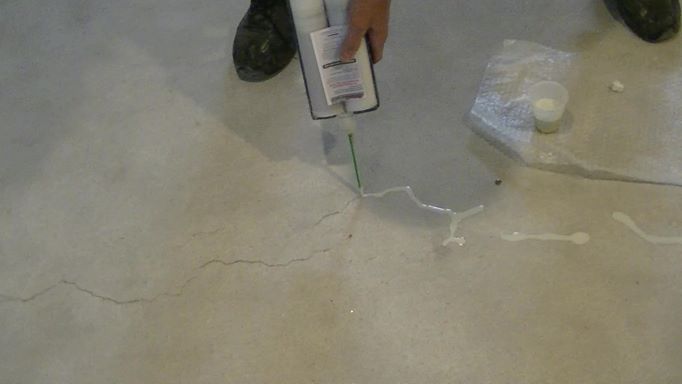 Repairing cracks in a basement concrete floor
Repairing cracks in a basement concrete floor
Almost cracks in basement floors can exist repaired by yourself with a do it yourself epoxy concrete scissure repair kit.
the half dozen steps for repairing a basement flooring crack.
Step 1. Clean out the fissure with a vacuum, remove whatsoever loose cement, rocks and debris.
Footstep ii. Inject the scissure weld resin into the fissure to wet it, it will before long go tacky.
STEP iii. Push the dry silica sand into the crevice with a putty knife to fill it.
STEP 4. Thoroughly saturate the sand with the crack weld resin and fill up it to the surface.
Stride 5. In 10 - fifteen minutes scrape the surface level with a putty knife.
Pace 6. Sand the surface shine or lightly grind it with a small concrete floor grinder for a great advent.
Hairline concrete cracks tin can be done without the sand. Broad concrete cracks can first exist filled partially with the sand and so start with footstep 2.
This fissure weld textile sets up very speedily, only do 10 - 15 feet at i time.
Watch this video of how I fix a basement flooring fissure!
If you have a really wet basement with standing water and puddles click on BASEMENT FLOOR WATERPROOFING to larn how to fix having a wet basement.
If your basement floor is just damp or moist click on WATERPROOFING BASEMENT FLOORS to learn how to have a dry basement.
Click on BASEMENT Flooring Bleed to learn how to install a bleed in your basement flooring.
To learn how to install insulation on top of your basement floor click on BASEMENT FLOOR INSULATION .
Return from Basement floor cracks to Basement floor
Return from Basement floor cracks to Everything Almost Concrete dwelling house folio
How To Repair Cracks In Cement Basement Floor,
Source: https://www.everything-about-concrete.com/basement-floor-cracks.html
Posted by: trapphambethinde.blogspot.com

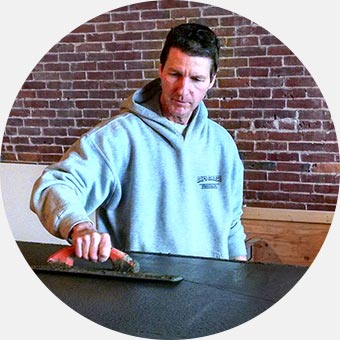



0 Response to "How To Repair Cracks In Cement Basement Floor"
Post a Comment